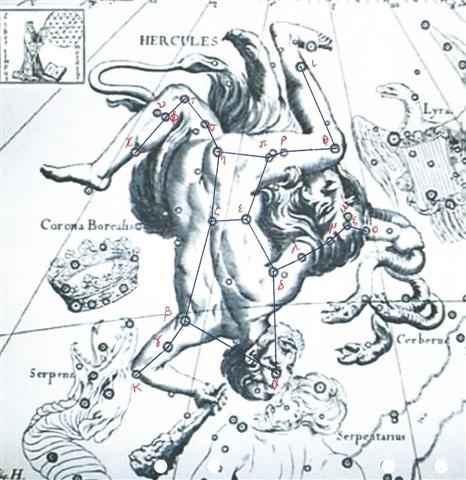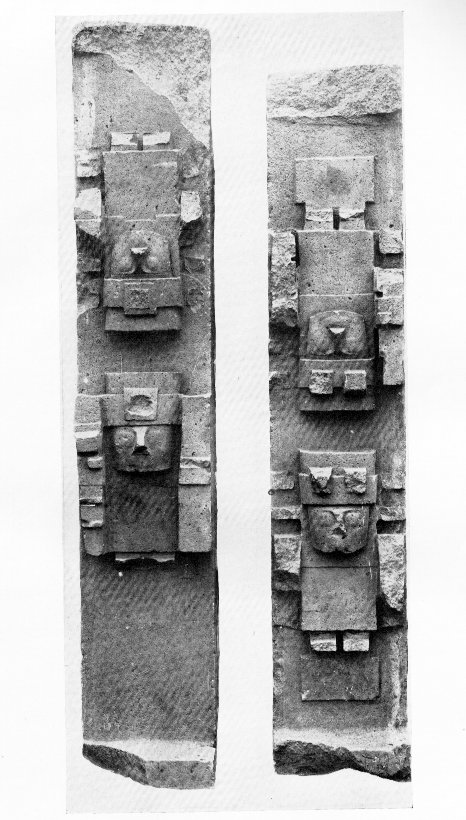The Rigel (Foot) year began at Ga1-14 and it was born where Thuban (the Dragon) culminated at midnight:
At the complementary side of this year Alrisha (the Knot) was culminating at midnight at the time when δ Herculis (Sarin, at his left shoulder) rose with the Sun.
Here there was a pair of heads close together in vertical confrontation. The Serpent Carrier stood on his feet, while Hercules had been overturned and succeeded by his tanist: ... Hercules first appears in legend as a pastoral sacred king and, perhaps because shepherds welcome the birth of twin lambs, is a twin himself. His characteristics and history can be deduced from a mass of legends, folk-customs and megalithic monuments. He is the rain-maker of his tribe and a sort of human thunder-storm. Legends connect him with Libya and the Atlas Mountains; he may well have originated thereabouts in Palaeolithic times. The priests of Egyptian Thebes, who called him Shu, dated his origin as '17,000 years before the reign of King Amasis'. He carries an oak-club, because the oak provides his beasts and his people with mast and because it attracts lightning more than any other tree. His symbols are the acorn; the rock-dove, which nests in oaks as well as in clefts of rocks; the mistletoe, or Loranthus; and the serpent. All these are sexual emblems. The dove was sacred to the Love-goddess of Greece and Syria; the serpent was the most ancient of phallic totem-beasts; the cupped acorn stood for the glans penis in both Greek and Latin; the mistletoe was an all-heal and its names viscus (Latin) and ixias (Greek) are connected with vis and ischus (strength) - probably because of the spermal viscosity of its berries, sperm being the vehicle of life. This Hercules is male leader of all orgiastic rites and has twelve archer companions, including his spear-armed twin, who is his tanist or deputy ... The tanist of Hercules would of course later, and in due time, be overturned by Hercules. Thus there were 2 kings, 'the bringer of food' and 'the bringer of spoils', probably for summer respectively for winter. ... All that remained on the anthill was the round wooden bowl, still bearing traces of the food and the finger-prints of its vanished owner, symbol of his body and of his human nature, as, in the animal world, is the skin which a reptile has shed ... Hercules was the Lord giver of bread and his tanist was the lower ranking Anax. Once I investigated these matters because I had perceived a similarity between the words Anakena and Anax:
... Anax ... is an ancient Greek word for '(tribal) king, lord, (military) leader'. It is one of the two Greek titles traditionally translated as 'king', the other being basileus. Anax is the more archaic term of the two, inherited from the Mycenaean period, and is notably used in Homeric Greek, e.g. of Agamemnon. The feminine form is ánassa, 'queen' (from wánakt-ja) ... ... The meaning of basileus as 'king' in Classical Greece is due to a shift in terminology during the Greek Dark Ages. In Mycenaean times, a gwasileus appears to be a lower-ranking official (in one instance a chief of a professional guild), while in Homer, Anax is already an archaic title, most suited to legendary heroes and gods rather than for contemporary kings. The Greek title has been compared to Sanskrit ... vanij, a word for 'merchant', but in the Rigveda once used as a title of Indra. The word could then be from PIE *wen-ag'-, roughly 'bringer of spoils' (compare the etymology of lord, 'giver of bread'). Archaic inscription (...)i wanakti, 'to the king', on [a}ceramic fragment, here shown upside down; a warrior bearing a spear and mounted on a horse is also depicted ...
The eldest of the 8 ancestors in Dogon mythology surely rose in the east with his head first and therefore when he later descended with his feet first he must have 'changed sex' in between: .. But in the fullness of time an obscure instinct led the eldest of them towards the anthill which had been occupied by the Nummo. He wore on his head a head-dress and to protect him from the sun, the wooden bowl he used for his food. He put his two feet into the opening of the anthill, that is of the earth's womb, and sank in slowly as if for a parturition a tergo ...
... Atea then became the wife of Rua-tupua-nui, Source of Great Growth, and they became the parents of all the celestial beings, first the shooting stars, then the Moon and the Sun, next the comets, then the multitude of stars and constellations, and finally the bright and dark nebulae. When this tremendous task had been accomplished Atea took a third husband, Fa'a-hotu, Make Fruitful. Then occurred a curious event. Whether Atea had wearied of bringing forth offspring we are not told, but certain it is that Atea and her husband Fa'a-hotu exchanged sexes. Then the [male] eyes of Atea glanced down at those of his wife Hotu and they begat Ru. It was this Ru who explored the whole earth and divided it into north, south, east, and west ... Maui was born from the topknot of his mother, another sign of a 'sex-change': ... Now Taranga listened to all this in amazement. For in the custom of our people, if a child was born before it finished growing in its mother's womb and died without knowing any of the pleasures of life, it was supposed to be buried with special prayers and ceremonies, otherwise it became a kind of evil spirit, always doing mischief to the human race and hurting them out of spite, because of having missed the happiness that they enjoy. All the evil spirits had a beginning of this sort. So Maui was a little demi-god of mischief. The story he had told was true, and as his mother listened she remembered it all. 'From the time I was in your womb,' Maui went on, 'I have known the names of these children of yours. Listen,' he said as he pointed to his brothers in turn. 'You are Maui mua, you are Maui roto, you are Maui taha, and you are Maui pae. And as for me, I am Maui potiki, Maui-the-last-born. And here I am.' When he had finished, Taranga had to wipe her eyes because there were tears in them, and she said: 'You are indeed my lastborn son. You are the child of my old age. When I had you, no one knew, and what you have been saying is the truth. Well, as you were formed out of my topknot you can be Maui tikitiki a Taranga.' So that became his name, meaning Maui-formed-in-the-topknot-of-Taranga. And this is very strange, because women in those days did not have topknots. The topknot was the most sacred part of a person, and only men had them ... |
||||||||||||||||||||||||||||||||||||||||||||||||||||||||||||||||||||||||||||||||||||||||||||||||||||||||||||||||||||||||||






